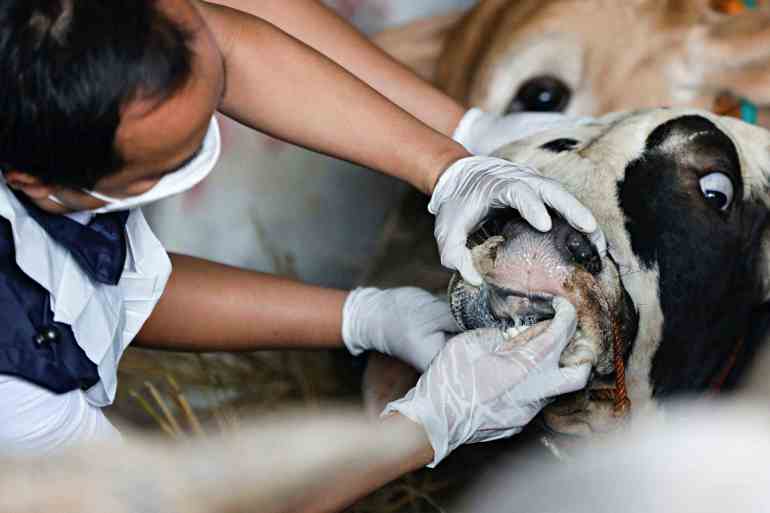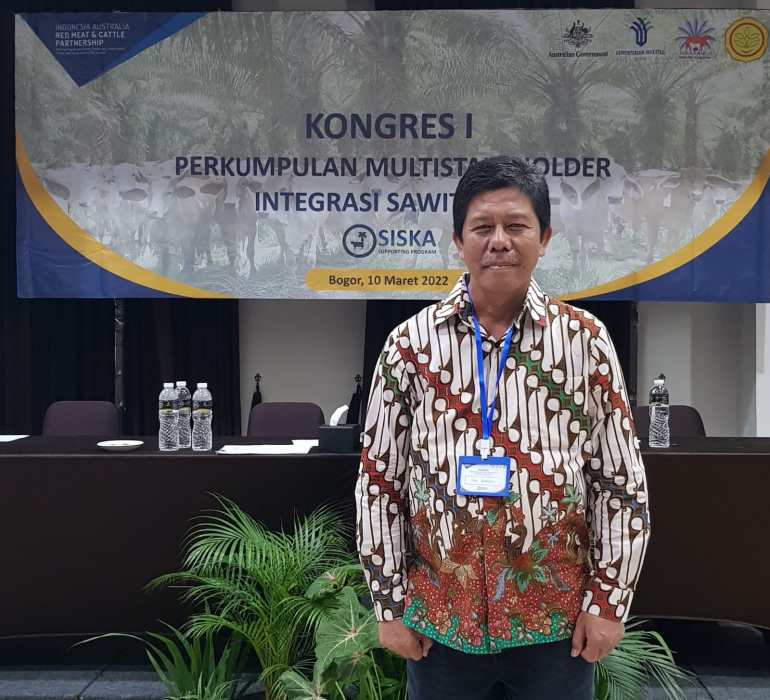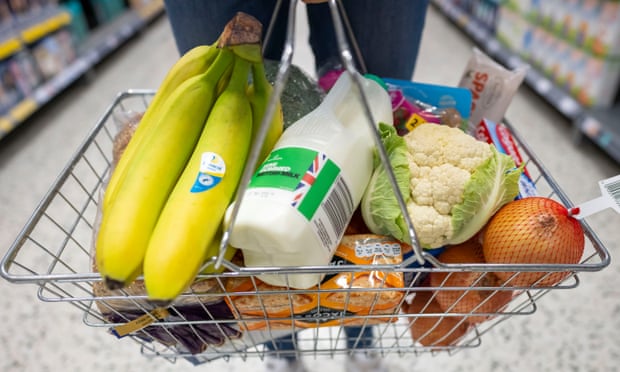Southeast Asian nation is grappling with its first outbreak of foot and mouth disease in nearly 40 years.

By Aisyah Llewellyn
Published On 12 Jul 2022
Medan, Indonesia – When dairy farmer Bagoes Cahyo noticed saliva pouring from the mouths of his cows, his heart sank.
Cahyo immediately suspected that his 70-strong herd of Friesian Holstein milkers were the latest victims of a vicious outbreak of foot and mouth disease that has swept Indonesia since May.
Within days, lesions and sores appeared around the cows’ mouths and noses. By the end of the week, all 70 of his herd were sick.
“When they got sick, their milk production drastically declined to about 10 percent,” Cahyo, who is based in the city of Malang, East Java, told Al Jazeera.
Stricken by illness, the cows struggled to eat, Cahyo said, drastically affecting their usual milk supply of 15 litres (4 gallons) per animal per day.
Even if their milk had been plentiful, Cahyo would not have been able to sell it, as his cows had to be put on antibiotics to aid their recovery.
Indonesia is currently in the grip of its first major outbreak of foot and mouth disease (FMD) in nearly 40 years. The Southeast Asian country successfully eradicated the virus behind the disease in 1986 and was declared FMD-free by the World Organisation for Animal Health in 1990. The disease affects hoofed animals such as cows, sheep, goats, pigs and deer, and is highly contagious.
Since May, more than 300,000 cases have been recorded across 21 provinces, prompting the Indonesian government to roll out a vaccine programme aimed at inoculating healthy cattle against the disease.
“This is the most feared disease in the world for the livestock industry,” Deddy Kurniawan, the head of the East Java II Indonesian Veterinary Association, told Al Jazeera. “No other virus is so horrific both economically and socially.”
Kurniawan said one of the reasons the virus is so ferocious is that it spreads quickly, causing symptoms within two to four days of infection, and can be passed easily in saliva, droplets, faeces, and milk and meat products.
“The viral shedding of the virus is so high that it is very difficult to avoid transmission unless you have really tight biosecurity measures in place,” he said.

As a result, the spectre of the virus stalks Joko Iriantono and his herd of 7,000 cows in Lampung on the island of Sumatra – although he has been able to avoid it until now.
Iriantono imports 2-year-old Brahman Cross cows from Australia every month and fattens them for 120 days on his farm before selling them for their meat.
Iriantono said there is a 6 percent increase year on year for beef in Indonesia due to a rising middle class “who want to eat steak”.
If a foot and mouth outbreak were to rip through the herd, Iriantono’s business would be devastated, so he has had to pay out of pocket to put in place strict measures to keep the disease at bay.
“We paid ourselves to get the cows vaccinated privately,” Iriantono told Al Jazeera, “and we have beefed up our biosecurity measures.”
These include ensuring that all vehicles and personnel on the farm are sprayed with disinfectant before they enter, and making staff change their clothes and shoes before they interact with the livestock.
According to Iriantono, the outbreak could have been better contained if widespread culling had taken place as soon as the first cases were announced in Java and Aceh back in May.
Culling livestock, known as “stamping out,” is widely thought to be the best way to eradicate FMD outbreaks quickly. The Indonesian government opted against widespread culling due to concerns about insufficient funds to compensate farmers for lost livestock.
As a result, only about 3,000 animals have been culled in some parts of Indonesia such as Bali, with many provinces focusing on vaccination and other measures such as antibiotic treatment.
It is not clear how the virus took hold.
Indonesia imports about 1.2 million cows capable of producing 300,000 tonnes of meat per year, Iriantono said, as domestic supply is not enough to meet demand.
Government regulations mean that farmers are only allowed to import livestock from countries that are free from FMD such as Australia and New Zealand.
Tim Harcourt, chief economist at the University of Technology in Sydney, said neighbouring Australia has so far escaped the same fate as Indonesia.
“Fortunately Australia has been able to contain the outbreak with world-class quarantine standards,” Harcourt told Al Jazeera. “Australian exports are clean and green so they’ll be boosted [as a result of the outbreak], but Indonesia imports will be adversely affected.”
The outbreak also comes at an inopportune moment, following the Eid al-Adha holiday on July 9-10. Known as the “Festival of Sacrifice,” the holiday sees cows, goats and sheep slaughtered across the country and the meat distributed to the poor or cooked at home.
Livestock sellers reported losses as farmers were forced to cull their herds, or couldn’t sell animals that were ill. Some said that customers were hesitant to buy animals for fear of the disease.

Kurniawan, however, said that the wider problem is that exports of animal products have been halted while the outbreak continues, which could affect the whole agriculture industry if countries refuse to import more and more products for fear they may be contaminated.
Kurniawan said that he has heard anecdotally of farmers having trouble exporting other non-livestock products, such as wood, following the outbreak.
“The disease can potentially be spread by agricultural products, workers, machinery and transportation, all of which could affect exports, so the impact of this virus could be extremely widespread,” he said.
SOURCE: AL JAZEERA
/cloudfront-ap-southeast-2.images.arcpublishing.com/nzme/LSXGI4QVZSZXDNZWY2MN4I4EQQ.jpg)
/cloudfront-ap-southeast-2.images.arcpublishing.com/nzme/JYF5QNV46W3FHERCWMFYJUHPGY.jpg)







:quality(70)/cloudfront-eu-central-1.images.arcpublishing.com/thenational/NI3TNXA7ECWVNJBBZKTKGLTI6A.jpg)
:quality(70)/cloudfront-eu-central-1.images.arcpublishing.com/thenational/NXJLDJPO6IPFKUM72OQ6MU3LRM.jpg)
:quality(70)/cloudfront-eu-central-1.images.arcpublishing.com/thenational/7FNLNXCFJ4NQTIKV47GJMHDOBA.jpg)
:quality(70)/cloudfront-eu-central-1.images.arcpublishing.com/thenational/FC6JPVOK55BY2C7RI5FGZHT254.jpg)
:quality(70)/cloudfront-eu-central-1.images.arcpublishing.com/thenational/V6PXRNVQX2B4DLLP3II4T2ZNLA.jpg)
:quality(70)/cloudfront-eu-central-1.images.arcpublishing.com/thenational/PFV24OH3D3GL3MTN7CNVVYB22Q.jpg)
:quality(70)/cloudfront-eu-central-1.images.arcpublishing.com/thenational/QW7CT45DBZ3YN67PYCDIBI2I5Y.jpg)


